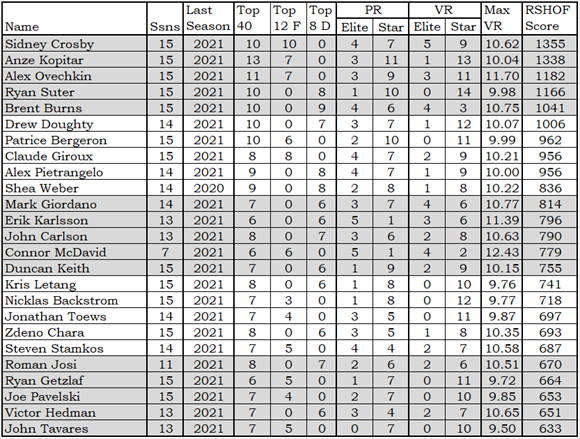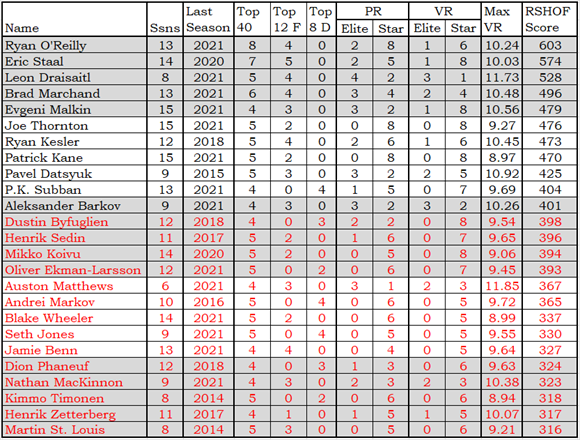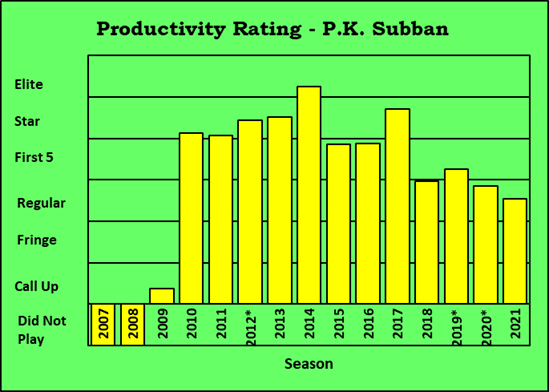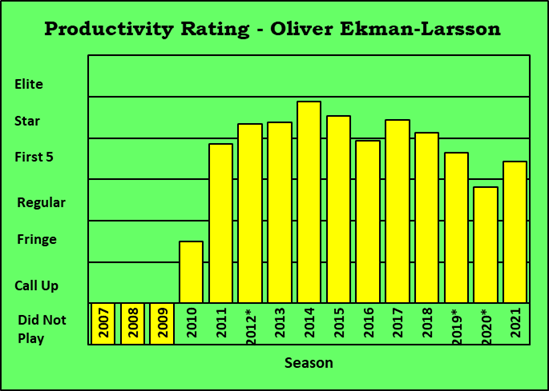It would seem there is nothing that can stir the blood more quickly than discussions about the Hall of Fame. Who should be in it? Who shouldn’t be in it? If this guy is in it, why isn’t that guy? How could it take so long for Alfredsson to get in?
We know that people are voted into the Hall of Fame (or selected by a committee, whatever), and we don’t entirely trust that process. Is there campaigning going on in the background? Are favours being sought, or are favours being repaid? Are there rigid criteria? (No.)
Thanks to naturalstattrick.com, I have a ton of data on players since the 2007/2008 season. And I know how to write a formula that will take disparate pieces of data from that mix and create a score. It’s time to put two and two together and come up with a Hall of Fame whose entry is determined by what a player has done in the regular season.
Limitations
The rating data starts at 2007/2008, so players like Bobby Orr and Guy Lafleur won’t be included because the statistics aren’t there. Sorry, Bobby.
Naturalstattrick.com does have goalie data and data from playoff games, which I am not using.
I presently have no idea how to rate a goalie. There isn’t much data in the data.
And this article isn’t called the “Regular Season Hall of Fame” for nothing. No playoff data will be used.
The Regular Season Hall of Fame will not consider a player’s playoff successes, his all-star appearances, his awards or his charitable works. Entry to the Regular Season Hall of Fame is based solely on regular season statistics.
Regular Season Hall of Fame Score
There was one guiding principal for me in designing the scoring system for the Regular Season Hall of Fame (RSHOF).197 Data intervals had to be treated fairly.
I didn’t use goals scored, but I could have. And I’ve seen systems where a player would get 20 points for scoring 100 goals, 30 for scoring 200 goals, and 40 for scoring 300 goals. I have a problem with that type of system.
Take two guys, one who scored 199 goals, the other who scored 201 goals. The first guy gets 20 points, the second guy gets 30 points: they are separated by two goals and the second player gets 10 more points.
Take two other guys, one who scored 101 goals, the other who scored 298 goals. The first guy gets 20 points, the second guy gets 30 points: they are separated by 197 goals and the second player gets 10 more points.
None of my scoring systems do that. If I’m assigning a score for anything, the first two guys noted above will get almost the same score, and the second two guys above will have vastly different scores.
As I mentioned a few paragraphs ago, I’m not using goals. In fact, I’m not using any normal statistic: not assists, not hits, not face-off wins.
I want the RSHOF players to have had lots of great seasons, and lots of high-value ratings. I want them to be the best players in the league for many seasons. To measure all that, I’ll use Productivity Rating (PR) and Value Rating (VR) as my main statistics. See Introduction to Productivity Rating and Introduction to Value Rating articles for more information.
For each career aspect I measure (with one exception), the formula for that aspect’s score will be:

I want multiple seasons of excellence to count more, so I square the count. This does contradict, to a degree, what I just said about treating data values equally. There will be a bigger difference between a player with six PR-Star seasons and one with four PR-Star seasons than players with four and two PR-Star seasons. I want multiple seasons of excellent performance to be the deciding factor in this process.
Longevity
Longevity will be measured by seasons played. No matter how small a number of games a player played in a season, if he played at all, he played that season. This over-values players who only play a handful of games each season, but there are very few of those players, and they do nothing else that will earn them RSHOF points, so it is not a problem.
This category has an aspect weight of 0.5. The exception for the general scoring pattern is that this category has a maximum score of 72, which is achieved after having played 12 seasons (12*12=144, 144*0.5=72).
Top-40 Player in a Season
This aspect will be measured by the number of seasons a player was in the top 40 players when ranked by PR-Score. It has a weight of 2. Claude Giroux has been a Top-40 player eight times, so his score for this aspect is (8*8*2) 128.
Top-12 Forward in a Season
This will be measured by the number of seasons a player was one of the top 12 forwards when ranked by PR-Score. It has a weight of 3. Patrice Bergeron has been a Top-12 forward six times, so his score for this aspect is (6*6*3) 108.
Top-8 Defenseman in a Season
This will be measured by the number of seasons a player was one of the top 8 defensemen when ranked by PR-Score. It has a weight of 3. Drew Doughty has been a Top-8 defenseman seven times, so his score for this aspect is (7*7*3) 147.
PR-Elite Season
PR-Elite is the highest PR category a player can get, and is very rarely attained (1% of players). This category has a weight of 10. Brent Burns was a PR-Elite four times, scoring (4*4*10) 160 for this aspect.
PR-Star Season
PR-Star is the second highest PR category and is rarely attained (3% of players). The category has a weight of 2. Ryan Suter has had ten PR-Star seasons, scoring (10*10*2) 200 for this aspect.
VR-Elite Season
VR-Elite is the highest VR category a player can get, and is very rarely attained. This category has a weight of 10. Alex Ovechkin was a VR-Elite three times, scoring (3*3*10) 90 for this aspect.
VR-Star Season
VR-Star is the second highest VR category and is rarely attained. The category has a weight of 2. Anze Kopitar has had thirteen VR-Star seasons, scoring (13*13*2) 338 for this aspect.
Career Maximum VR-Score
This category measures the peak value a player had during their career, and uses VR-Score. The category has a weight of 1. Sidney Crosby’s highest VR-Score was 10.62, so he got (10.62*10.62*1) 112.7 for this category.
RSHOF Score
Add all the individual aspects together, rounding to the nearest whole number. Let’s use Joltin’ Joe Thornton as an example.

Joe has played 15 seasons since 2007/2008. He was in the top 40 five times and was a top-12 forward twice. He had no PR-Elite seasons and eight PR-Star seasons. He also had no VR-Elite seasons and eight VR-Star seasons. His VR-Score was 9.27 (VR-Star category is for VR-Scores from 8.00 to 9.99). The category scores are below the counts in the table above, and the total score for Jumbo is 476.
If a player’s RSHOF score is 400 or more, he’s in the Regular Season Hall of Fame. Congratulations, Mr. Thornton. The following two tables show the current top fifty players when ranked by RSHOF Score, along with their counts. Two tables were used because it works better for the printed article.

36 players are in the Regular Season Hall of Fame (the 25 above and the eleven top players on the next table).
They are 1.3% of the players who have played since 2007/2008, but they have had 82% of the VR-Elite seasons, 71% of the PR-Elite seasons, more than half of the Top-12 Forward and Top-8 Defenseman seasons, 44% of the Top-40 player seasons, 41% of the VR-Star seasons and 33% of the PR-Star seasons. That’s a lot of results crammed into a small number of players.

When you get down to the very bottom of the RSHOFers, maybe there could be a quibble or two. P.K. Subban just qualifies. His Career PR-Chart shows his period of success quite clearly.

His best season was 2014/2015, his second last season in Montreal. Clearly, something happened before the start of the next season, as his PR-Score was almost a category-and-a-half lower. 2017/2018 looked like a recovery, but it was followed by another significant dip.
Since then, his productivity has been declining steadily.
But he was a top player in the league for a couple of seasons: four times in the top 40, four times a top eight defenseman, one PR-Elite and five PR-Star seasons, seven VR-Star seasons. Only 29 players in the league have had seven or more VR-Star seasons.
The players in red font are not in the RSHOF, as their RSHOF-Score is less than 400. The older players on the list, such as Andrei Markov, would absolutely have qualified if the data from their pre-2007 seasons existed.
Henrik Sedin would absolutely have made the RSHOF with just one more season of data. Daniel Sedin would not have made the RSHOF, even with all of his extra data. Daniel always rated just a little below Henrik, but he was lower enough that he missed getting PR-Star seasons and VR-Star status. Two of his best seasons were pre-2007 but they wouldn’t have gotten him to 400 points.
Dustin Byfuglien is missing two seasons of pre-2007 data, but I don’t think those two seasons would have helped get him into the RSHOF. He played a total of 34 games and didn’t do much, so he wouldn’t have had any extra “good seasons”.

Oliver Ekman-Larsson is one of those who isn’t likely to make it into the RSHOF.
He’s played twelve seasons, so he’s hit his maximum score for longevity. Playing more seasons won’t help him.
He is very unlikely to be in the top 40 players the top 8 defensemen ever again. He is very unlikely to get a PR-Star season ever again, and he’d need two of those to get another VR-Star rating.
He needs one more great season to get in, and it looks like he’s past putting up great seasons. Below is a table that shows some data from his last great season (2017) and his last actual season (2021).

To get back to PR-Star level, Ekman-Larsson needs to score nine more goals and get four more assists, and play an extra 1.5 minutes per game, and improve his Corsi by +2.5 per game. That type of turn-around doesn’t happen at the end of one’s career.
Knocking on the Door
So, who isn’t in the RSHOF but is likely to get in? Glad you asked.
My top six players on watch are in the table below.

Matthews just needs one more of his regular seasons to get in: a top 40 player, a PR-Star season with another VR-Elite rating would absolutely do it. And that would be a step down from what he did last season.
Jones and MacKinnon will get there with two more years of their standard play: they’ll be close next year and gain entry the year after.
Scheifele, Zibanejad and Stone are all players who could get in but need to stay healthy and have a great 2022 season to have a reasonable shot. They are all entering their period of decline, and it doesn’t take much of a drop to take one out of the Top-40/PR-Star level of play they need.
Ryan McDonagh, Jamie Benn and Alex Goligoski do not have a realistic chance. To get into the RSHOF, they would have to have one or two more PR-Star level seasons, and that is very unlikely to happen.
The Keltner List = The Osgoode List
I have borrowed many ideas from Bill James, the author of the annual Bill James Baseball Abstract: The Regular Season Hall of Fame sprang from his work.
He did quite a lot of writing about the baseball Hall of Fame. He developed a formula that looked at a player’s career accomplishments and it did an excellent job of identifying those who were in the Hall of Fame, and those active players who were likely to go in. It didn’t identify all players in the Hall of Fame because there are some surprisingly poor players in there. Politics is everywhere.
In an article from the 1985 edition of the Abstract he wrote a series of questions one could ask about a player, which would guide your thoughts on whether he should be in the Hall of Fame. He called it the Keltner List: the article was about people trying to get Ken Keltner into the Hall of Fame. He used the questions to help people understand his logic.
I’ve borrowed the idea and most of the questions, reshaping them for hockey. Here is the Osgoode List. To clarify one point, this list is meant for Halls of Fame where membership is determined by voting, not solely by statistics.
- Was he ever regarded as the best player in hockey? Did anybody, while he was playing, ever suggest he was the best player in hockey?
- Was he the best player at his position?
- Was he the best player on his team?
- If this player was the best player on his team, is it likely that the team could win the Stanley Cup?
- Did he have an impact on a number of playoffs?
- Was he a good enough player that he could continue to play regularly after passing his prime?
- Is he the best player who is eligible for the Hall of Fame but not in?
- Are most players who have comparable career statistics in the Hall of Fame?
- Do the player’s numbers meet Hall of Fame standards?
- Is there any evidence to suggest that the player was significantly better or worse than is suggested by his statistics?
- How many MVP-type seasons did he have? Did he ever win an MVP award? If not, how many times was he close?
- How many All-Star-type seasons did he have?
You can see how this list impacted the RHSOF calculations. Questions 1, 2, 3, 6, 7, 11 and 12 are directly answered by the calculations. Questions 8 and 9 are addressed by the process itself. Questions 5 and 10 are not part of the RHSOF process, which doesn’t look at playoff data and doesn’t search for deeper meanings in the data. That’s something voters do, so they can add unqualified members to the hall or delay the entry of qualified players.
